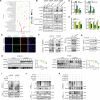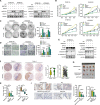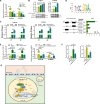The miR-19b-3p-MAP2K3-STAT3 feedback loop regulates cell proliferation and invasion in esophageal squamous cell carcinoma
- PMID: 33660414
- PMCID: PMC8096789
- DOI: 10.1002/1878-0261.12934
The miR-19b-3p-MAP2K3-STAT3 feedback loop regulates cell proliferation and invasion in esophageal squamous cell carcinoma
Abstract
Esophageal squamous cell carcinoma (ESCC) is one of the most refractory malignancies worldwide. Mitogen-activated protein kinase 3 (MAP2K3) has a contradictory role in tumor progression, and the function and expression patterns of MAP2K3 in ESCC remain to be determined. We found that MAP2K3 expression to be downregulated in ESCC, and MAP2K3 downregulation correlated with clinically poor survival. MAP2K3 inhibited ESCC cell proliferation and invasion in vitro and in vivo. MAP2K3 suppressed STAT3 expression and activation. Mechanistically, MAPSK3 interacted with MDM2 to promote STAT3 degradation via the ubiquitin-proteasome pathway. Furthermore, exosomal miR-19b-3p derived from the plasma of patients with ESCC could suppress MAP2K3 expression to promote ESCC tumorigenesis. STAT3 was found to bind to the MIR19B promoter and increased the expression of miR-19b-3p in ESCC cells. In summary, our results demonstrated that the miR-19b-3p-MAP2K3-STAT3 feedback loop regulates ESCC tumorigenesis and elucidates the potential of therapeutically targeting this pathway in ESCC.
Keywords: MAP2K3; MDM2; STAT3; miR-19b-3p.
© 2021 The Authors. published by John Wiley & Sons Ltd on behalf of Federation of European Biochemical Societies.
Conflict of interest statement
The authors declare no conflicts of interest.
Figures







Similar articles
-
Circular RNA hsa_circ_0000654 promotes esophageal squamous cell carcinoma progression by regulating the miR-149-5p/IL-6/STAT3 pathway.IUBMB Life. 2020 Mar;72(3):426-439. doi: 10.1002/iub.2202. Epub 2019 Nov 28. IUBMB Life. 2020. PMID: 31778020
-
Exosomal lncRNA ZFAS1 regulates esophageal squamous cell carcinoma cell proliferation, invasion, migration and apoptosis via microRNA-124/STAT3 axis.J Exp Clin Cancer Res. 2019 Nov 27;38(1):477. doi: 10.1186/s13046-019-1473-8. J Exp Clin Cancer Res. 2019. PMID: 31775815 Free PMC article.
-
MiR-874-3p is an independent prognostic factor and functions as an anti-oncomir in esophageal squamous cell carcinoma via targeting STAT3.Eur Rev Med Pharmacol Sci. 2018 Nov;22(21):7265-7273. doi: 10.26355/eurrev_201811_16261. Eur Rev Med Pharmacol Sci. 2018. PMID: 30468470
-
CircSLC22A3 inhibits the invasion and metastasis of ESCC via the miR-19b-3p/TRAK2 axis and by reducing the stability of m6A-modified ACSBG1 mRNA.BMC Cancer. 2025 May 30;25(1):971. doi: 10.1186/s12885-025-14390-8. BMC Cancer. 2025. PMID: 40448098 Free PMC article.
-
Impact of miRNAs involved in the STAT3 signaling pathway on esophageal cancer (Review).Oncol Rep. 2025 Feb;53(2):27. doi: 10.3892/or.2024.8860. Epub 2025 Jan 3. Oncol Rep. 2025. PMID: 39749694 Review.
Cited by
-
The roles of exosomes in esophageal cancer.Discov Oncol. 2024 Aug 27;15(1):371. doi: 10.1007/s12672-024-01259-8. Discov Oncol. 2024. PMID: 39190048 Free PMC article. Review.
-
Quadruple and Truncated MEK3 Mutants Identified from Acute Lymphoblastic Leukemia Promote Degradation and Enhance Proliferation.Int J Mol Sci. 2021 Nov 11;22(22):12210. doi: 10.3390/ijms222212210. Int J Mol Sci. 2021. PMID: 34830095 Free PMC article.
-
PITX1 suppresses osteosarcoma metastasis through exosomal LINC00662-mediated M2 macrophage polarization.Clin Exp Metastasis. 2023 Feb;40(1):79-93. doi: 10.1007/s10585-022-10192-5. Epub 2022 Nov 5. Clin Exp Metastasis. 2023. PMID: 36334221 Free PMC article.
-
Dissection of the MKK3 Functions in Human Cancer: A Double-Edged Sword?Cancers (Basel). 2022 Jan 18;14(3):483. doi: 10.3390/cancers14030483. Cancers (Basel). 2022. PMID: 35158751 Free PMC article. Review.
-
Development of a TLR-Based Model That Can Predict Prognosis, Tumor Microenvironment, and Drug Response for Esophageal Squamous Cell Carcinoma.Biochem Genet. 2024 Oct;62(5):3740-3760. doi: 10.1007/s10528-023-10629-w. Epub 2024 Jan 11. Biochem Genet. 2024. PMID: 38206423
References
-
- Paez JG, Janne PA, Lee JC, Tracy S, Greulich H, Gabriel S, Herman P, Kaye FJ, Lindeman N, Boggon TJ et al. (2004) EGFR mutations in lung cancer: correlation with clinical response to gefitinib therapy. Science 304, 1497–1500. - PubMed
-
- Schadendorf D, van Akkooi ACJ, Berking C, Griewank KG, Gutzmer R, Hauschild A, Stang A, Roesch A & Ugurel S (2018) Melanoma. Lancet 392, 971–984. - PubMed
Publication types
MeSH terms
Substances
LinkOut - more resources
Full Text Sources
Other Literature Sources
Medical
Molecular Biology Databases
Research Materials
Miscellaneous

